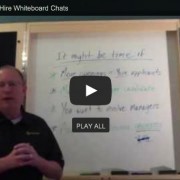Navigating the Holiday Planning Process
Although it is still summer, many employees’ minds are starting to think of cooler days and winter holidays. Eleven holidays, many religious based, are in the month of December alone. As winter holidays rapidly approach, it often means an influx of employees requesting time off to celebrate or to use any last paid time off (PTO) before they lose it. The holiday season is not meant to cause additional stress within a company so planning ahead is crucial for HR professionals to prepare for holiday time off requests. Through clearly communicated policies and utilizing an organized process, employees can enjoy the holiday season without saying “Bah Humbug”!
Holiday Planning Policies
As HR professionals know, there is a policy for everything, well most everything. Companies tend to do well with creating a PTO policy so one is “in place”, but not all policies are clearly defined leaving opaqueness instead of transparency around such a key benefit for employees. HR professionals, take a moment to review your company’s PTO policy. Are updates necessary? Does the PTO policy specifically include strategies to address PTO requests at busy holiday seasons? To alleviate confusion or potential claims of discrimination, ensure there are specific details and parameters regarding holiday leave clearly defined in the PTO policy housed within the company’s employee handbook.
(Note to reader: Red flag raised! If your company does not have a PTO policy included in the company’s employee handbook, add that as a priority item on your To Do list. If there is no up-to-date employee handbook or policies formally communicated to your employees, drop everything and let ExactHire show you how you can do that electronically through your own onboarding site.)
Holiday Planning Communication
As soon as company holiday closure dates are confirmed within a company, announce those to employees so they can start planning their time off, if they choose to take an. Create a shared calendar accessible to employees so the team is aware of when employees are out of the office. This empowers employees to proactively plan for their time off needs and adjust time off requests, if necessary, to ensure adequate coverage so business can flow as usual. If a company opts to use blackout dates (dates that employees are not allowed to request off), communicate which dates are blacked out as early as possible, and explain why those dates are unavailable for PTO use so employees understand the rationale. A few key items are essential to address in a holiday leave policy:
Common Holiday Questions
Who is eligible to take paid time off during the holiday season? Are only full-time employees eligible for paid time off, or are part-time employees afforded paid time off as well? Can an employee take unpaid time off if needed?
Is there a limit of consecutive days that can be taken off by an employee? Setting a limit of consecutive days can mitigate the chance that other teammates might not get to take time off also or be tasked with providing ongoing, additional coverage to offset the employee’s extended absence.
Who approves holiday PTO requests? Who approves an employee’s holiday PTO request? Does the employee submit the request to their manager, human resources or another party? Specify the chain of command in the holiday policy in case an approver is out of the office.
Is there a due date for PTO requests? While flexibility is essential in the work environment, having a solid due date of at least two to four weeks in advance for PTO requests is not uncommon, especially at peak vacation times. Knowing who will be in and out of the department helps managers plan for staffing needs with the goal of minimizing last minute employee shortages. HR professionals and managers need to maintain a degree of flexibility though as it is possible that employees might have time off requests that occur outside the typical due date due to sudden family events or travel changes. When those requests occur, it is crucial to evaluate the impact of the time off on the company’s needs and how it can positively or negatively affect the employee if the time off request is approved or denied. If an employee habitually requests time off without adequate time for a department to prepare, that is something to address, but if an employee requests time off quickly but rarely, consider the request.
If the same day(s) is requested, who gets first-dibs? This can be a tough one so having a policy with the terms outlined will help. Two main routes to solve this scenario are common, and the more effective route will vary with the culture and size of your organization. One option is to let seniority rule which has its pros and cons. It is a way to show appreciation for an employee’s work longevity. On the other hand, some hard working but newer employees will lose the request to more tenured, and potentially less productive, employees. Another option is “first come, first served” where the first employee, regardless of seniority or performance, gets the time off.
Are there benefits if an employee does not take vacation time during the holiday season?
Some employees prefer to save their time off for other times of the year and are willing to help provide crucial coverage. List any benefits or perks like extra pay, company swag, gift cards or food that employees will get if they provide extra help in staffing while other employees are out of the office. For those employees who do not get their time off granted, morale might plummet so find ways to boost motivation. As with employees who voluntarily choose not to take vacation time during the holiday season and provide coverage, grant similar perks to those employees who do not get all or part of their PTO requests fulfilled and are providing coverage as well.
Start Planning Early
Summer is a great time for HR professionals and managers to send reminders to employees to start planning for their holiday time off needs. Instead of trying to maneuver and schedule time off during the hustle and bustle of the holiday season. Be aware that the EEOC has established guidelines on time off regarding religious accommodations for companies with 15+ employees to help companies mitigate risk of employee discrimination. Since ExactHire does not provide legal counsel, consult with your company’s legal team to confirm that the company’s PTO policy adheres to EEOC policies and supports a climate of diversity and company productivity. Effectively planning now for future holiday absences can help an organization run more smoothly where employees feel supported by leadership, and leadership feels confident in Its employees’ commitment to company goals.








